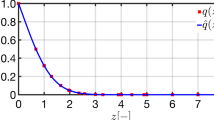Abstract
THE traditional type of elastomer consists of a random network of kinetically free chains linked together by means of stable cross-links: in the case of vulcanized Hevea rubber by sulphur bridges and in the case of the elastic insect protein, resilin, by di- and tri-tyrosine residues1. The elastic force is caused by the random thermal agitation of the chains whose configurational entropy decreases with strain, while the changes in internal energy remain negligible. Some problems posed by the elastic behaviour of elastin, however, have led us to consider a fundamentally different type of elastomer.
Similar content being viewed by others
References
Andersen, S. O., Acta Physiol. Scand., 66, Suppl. 263 (1966).
Hoeve, C. A. J., and Flory, P. J., J. Amer. Chem. Soc., 80, 6523 (1958).
Volpin, D., and Ciferri, A., Nature, 225, 382 (1970); and in Chemistry and Molecular Biology of the Intercellular Matrix (edit. by Balazs, E. A.), 1, 691 (Academic Press, London, 1970).
Wiegand, W. B., and Snyder, J. W., IRI Trans., 10, 234 (1934).
Weis-Fogh, T., J. Mol. Biol., 3, 520 (1961).
Weis-Fogh, T., and Andersen, S. O., Proc. NATO Advanced Study Inst., Santa Margherita, 1969; Chemistry and Molecular Biology of the Intercellular Matrix (edit. by Balazs, E. A.), 1, 671 (Academic Press, London, 1970).
Partridge, S. M., in The Physiology and Biochemistry of Muscle as a Food (edit. by Briskey, E. F., Cassens, R. C., and Trautman, F. C.), 327 (Univ. Wisconsin Press, Madison, 1966).
Thomas, J., Elsden, D. F., and Partridge, S. M., Nature, 200, 651 (1963).
Franzblau, C., Sinex, F. M., Faris, B., and Lampidis, R., Biochem. Biophys. Res. Commun., 21, 575 (1965).
Lent, R. W., Smigh, B., Salcedo, L. L., Faris, B., and Franzblau, L., Biochemistry, 8, 2837 (1969).
Partridge, S. M., Advan. Protein Chem., 17, 227 (1962).
Sandberg, L. B., Hackett, T. N., and Carnes, W. H., quoted by Partridge, S. M., in Chemistry and Molecular Biology of the Intercellular Matrix (edit. by Balazs, E. A.), 1, 593 (Academic Press, London, 1970).
Partridge, S. M., Davis, H. F., and Adair, G. S., Biochem. J., 61, 11 (1955).
Clarke, E. W., and Rothschild, Lord, Proc. Roy. Soc., B, 147, 316 (1957).
Handbook of Chemistry and Physics (edit. by Weast, R. C.), forty-eighth ed., F.29 (Chemical Rubber Co., Cleveland, 1967).
Nemethy, C., and Scheraga, H. A., J. Phys. Chem., 66, 1773 (1962).
Author information
Authors and Affiliations
Rights and permissions
About this article
Cite this article
WEIS-FOGH, T., ANDERSEN, S. New Molecular Model for the Long-range Elasticity of Elastin. Nature 227, 718–721 (1970). https://doi.org/10.1038/227718a0
Received:
Revised:
Issue Date:
DOI: https://doi.org/10.1038/227718a0
- Springer Nature Limited
This article is cited by
-
A maximum dissipation thermodynamic multi-scale model for the dynamic response of the arterial elastin–water system
Acta Mechanica (2010)
-
Making biological materials
Journal of Bionic Engineering (2005)





